Discover how the buckler symbolizes divine protection in biblical texts, revealing deep insights into spiritual warfare and faith.
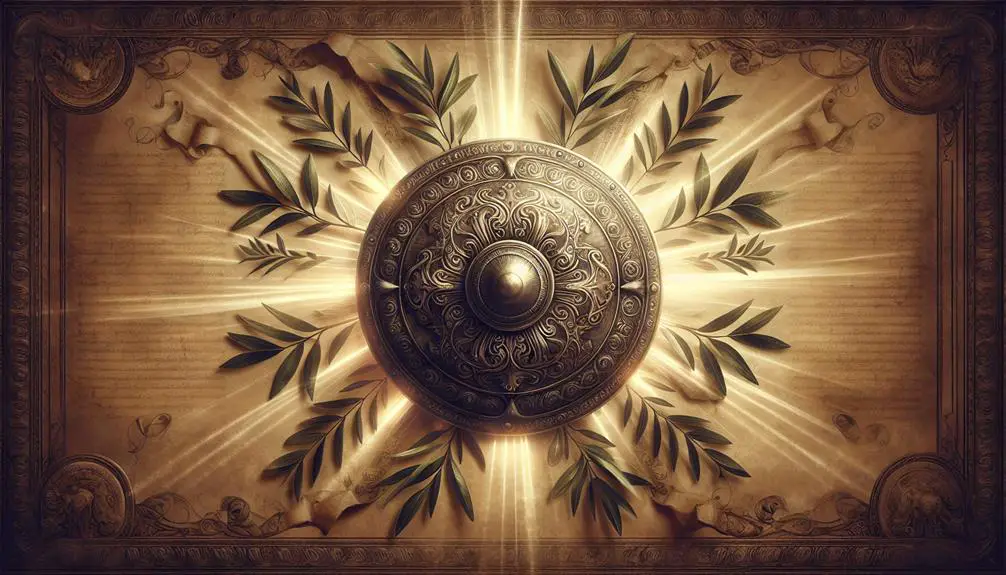
Buckler Meaning in the Bible
As they say, a good defense is a strong offense, and in the Biblical context, the buckler stands as a testament to this timeless strategy.
You'll find that the buckler, beyond its historical significance as a form of shield, carries profound symbolic weight throughout the scriptures. It's often referenced as a metaphor for divine protection and spiritual warfare, offering a deep well of insight into how ancient peoples viewed their relationship with the divine.
As you explore the multifaceted role of the buckler, you'll uncover layers of meaning that could transform your understanding of biblical texts and their application to modern-day spiritual battles.
What hidden truths might this ancient symbol reveal to you about faith, protection, and warfare in the spiritual realm?
Key Takeaways
- Bucklers symbolize divine protection and spiritual fortification in biblical contexts.
- They represent the Armor of God, emphasizing spiritual readiness against evil forces.
- The buckler reflects strength in faith and God's unwavering commitment to safeguard believers.
- It serves as a metaphor for psychological resilience and divine watch over believers.
Historical Significance of Bucklers
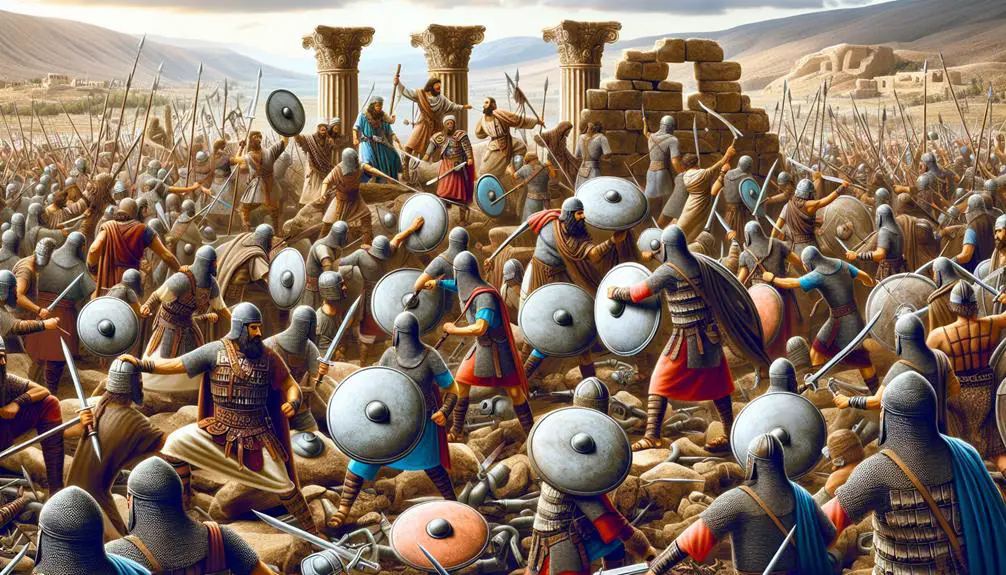
Bucklers, small shields pivotal for individual defense, played a significant role in ancient warfare, shaping strategies and personal combat tactics within biblical contexts. These compact shields, easy to maneuver and less cumbersome than their larger counterparts, allowed soldiers to adopt a more agile and defensive posture in battle. You'll find that their introduction marked a pivotal point in combat evolution, enabling a transition from the phalanx formations of antiquity to the more individualized combat seen in medieval tactics.
As you delve deeper, it's clear that the buckler's influence extended beyond mere physical defense. It facilitated a shift in military strategy, emphasizing speed, agility, and precision. Medieval tactics, heavily reliant on the effectiveness of foot soldiers, were profoundly impacted by the widespread use of bucklers. These small shields enabled soldiers to engage in close combat more effectively, parrying blows and counterattacking with greater ease. The buckler's versatility made it an indispensable tool in the arsenal of medieval warriors, influencing the development of fighting techniques that became hallmarks of the era.
Furthermore, the buckler's role in combat evolution can't be overstated. It bridged the gap between the shield walls of ancient formations and the dueling knights of the medieval period. Its adaptability made it suitable for various combat scenarios, from open battlefield engagements to narrow street fights. The buckler, though modest in size, significantly contributed to the dynamic nature of warfare, reflecting the changing face of battle from ancient times through the medieval period.
Biblical References to Bucklers
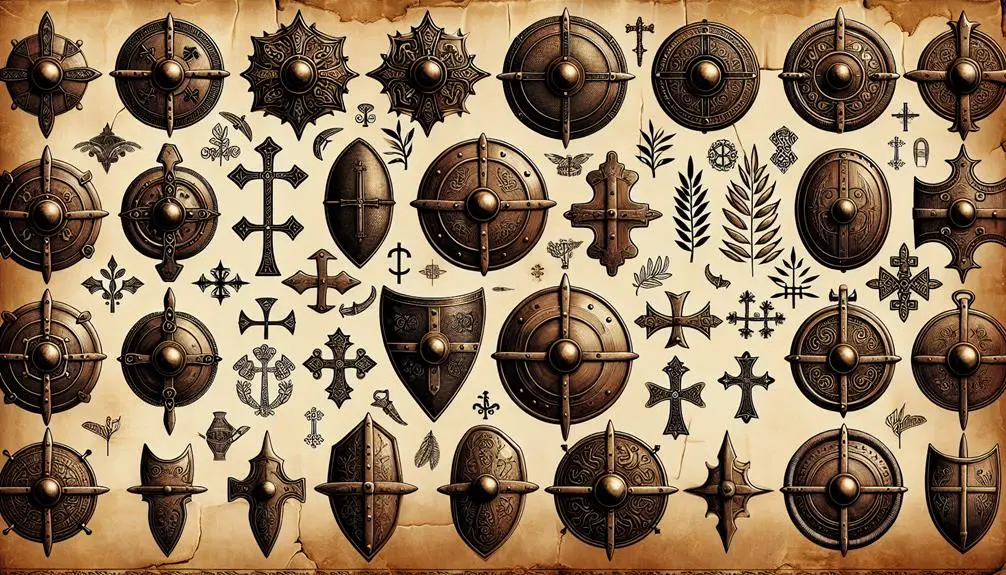
Having explored the historical significance of bucklers, let's now examine their depiction and symbolism within biblical texts. The Bible references bucklers in various contexts, primarily related to warfare tactics and the construction materials used in their making. These references not only underscore the physical attributes of bucklers but also provide insights into their strategic importance in ancient combat scenarios.
Reference |
Context |
Construction Material |
|---|---|---|
Psalm 35:2 |
Divine protection |
Not specified |
Jeremiah 46:3 |
Preparations for war |
Leather |
Ezekiel 26:8 |
Siege warfare |
Bronze |
2 Chronicles 9:15 |
King Solomon's armory |
Gold |
In Psalm 35:2, the buckler is metaphorically used to represent God's protection, devoid of specific details on its construction. However, this reference still brings to light the buckler's symbolic significance as a defensive tool. Jeremiah 46:3 provides a more literal description, mentioning "bucklers and shields," and highlights the use of leather in their construction, indicative of the period's warfare tactics that favored mobility and speed.
Ezekiel 26:8 provides a glimpse into siege warfare tactics, mentioning "bucklers and shields" made of bronze, emphasizing the need for sturdier materials in prolonged combat situations. Lastly, 2 Chronicles 9:15, referencing gold bucklers made for King Solomon, showcases the luxurious side of warfare accoutrements, indicating not just practical use in battle but also their role as symbols of wealth and power.
These references collectively paint a detailed picture of the buckler's multifaceted role in biblical times, highlighting not only their practical applications in warfare but also their symbolic significance, material diversity, and tactical importance.
Symbolism of Protection
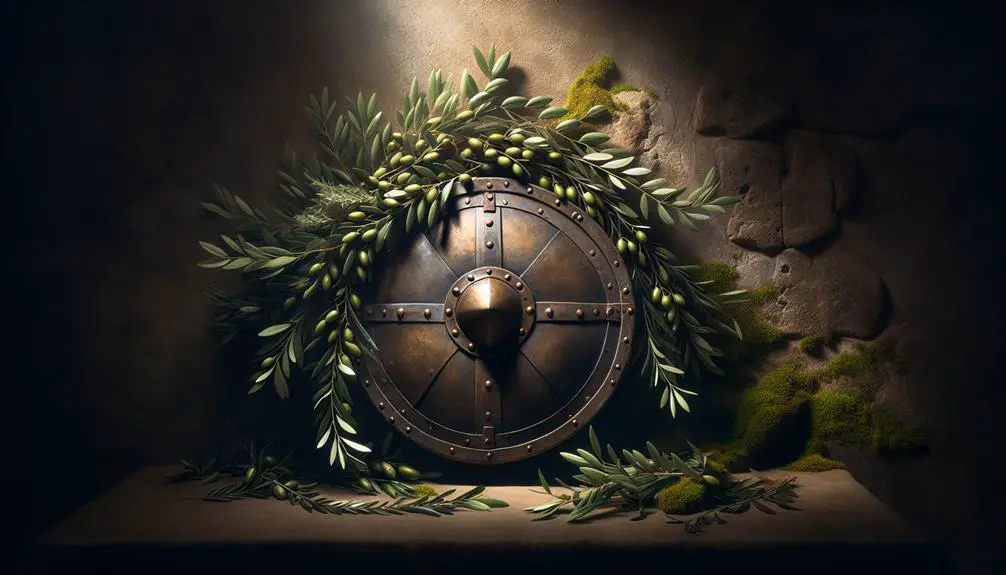
As you explore the symbolism of protection in biblical texts, you'll encounter the 'Shield of Faith,' emblematic of spiritual defenses against life's adversities.
The theme of Divine Protection underscores God's safeguarding presence, offering a deeper understanding of biblical assurances.
Lastly, the 'Armor of God' metaphorically equips believers for spiritual battles, emphasizing resilience and divine support in overcoming challenges.
Shield of Faith
In biblical context, the 'Shield of Faith' symbolizes divine protection and steadfast belief, underscoring the spiritual armor believers are encouraged to wield against life's adversities. This concept is pivotal, offering insights into how faith durability and shield metaphors converge to illustrate spiritual resilience.
- Faith Durability: Faith is depicted as unbreakable, capable of withstanding any spiritual assault, much like a shield in battle.
- Shield Metaphors: The Bible uses shield imagery to communicate the protective power of faith against doubts and fears.
- Spiritual Armor: The 'Shield of Faith' is part of a broader spiritual armor, emphasizing the importance of a well-rounded defense.
- Adversities: It represents the believer's defense mechanism against various forms of spiritual and moral challenges.
Divine Protection Themes
Throughout biblical narratives, divine protection is frequently symbolized through powerful motifs that offer believers a sense of security and guidance amidst life's tumultuous journeys. These motifs aren't merely ornamental but serve as emblematic representations of protection strategies and safeguard practices divinely instituted for the faithful.
Analyzing these themes, you'll discover that they're imbued with rich layers of meaning, each carefully crafted to communicate the multifaceted nature of divine guardianship. This protective symbolism transcends mere physical safety, encompassing spiritual, emotional, and psychological fortitude. It's a comprehensive approach that reinforces the notion that divine protection is all-encompassing, offering a bulwark against the myriad challenges that believers may face.
Thus, the biblical depiction of divine protection is both a promise and a practice, deeply rooted in the spiritual heritage of faith.
Armor of God
Delving into the Armor of God unveils a profound layer of biblical symbolism, offering believers not only physical but also spiritual fortification against life's adversities. This concept emphasizes the necessity for spiritual readiness and the development of prayer strategies as crucial elements in a believer's life.
- Belt of Truth: Anchors you in honesty, making you less susceptible to deception.
- Breastplate of Righteousness: Protects your heart and soul from the assaults of guilt and sin.
- Shield of Faith: Allows you to deflect the fiery darts of doubt, fear, and temptation.
- Helmet of Salvation: Secures your thoughts, reminding you of your eternal hope.
These components illustrate a comprehensive strategy for spiritual warfare, emphasizing the importance of equipping oneself with divine protection.
Buckler as Divine Safeguard

Why is the buckler, a symbol of divine protection, so prominently featured in biblical texts? This question invites you into an exploration of its significance, not only in ancient times but also through modern interpretations and cultural adaptations. The buckler, a small shield, represents God's safeguarding presence, a theme woven deeply into the fabric of biblical narratives. It's a tangible symbol of the divine commitment to protect and guide.
In analyzing the buckler's role, it's crucial to consider how cultural adaptations have influenced its perception. Over centuries, the buckler has transcended its original, literal meaning. It's evolved from a physical artifact into a metaphor for God's protection against spiritual and moral adversities. This evolution reflects broader changes in religious practices and beliefs, illustrating how ancient symbols are reinterpreted to resonate with contemporary audiences.
Modern interpretations of the buckler further highlight its significance as a divine safeguard. These perspectives often emphasize the personal relationship between the individual and the divine, suggesting that God's protection isn't only a communal but also a deeply personal promise. This shift underlines the adaptability of biblical symbols, demonstrating their ability to offer comfort and reassurance in varied contexts.
The buckler's enduring presence in religious discourse underscores its powerful symbolism. As a divine safeguard, it serves as a reminder of the protective embrace offered by faith, bridging historical contexts and modern experiences. Through scholarly analysis, one can appreciate the layers of meaning behind this potent symbol, enriching one's understanding of its role in spiritual life.
Armor in Spiritual Warfare
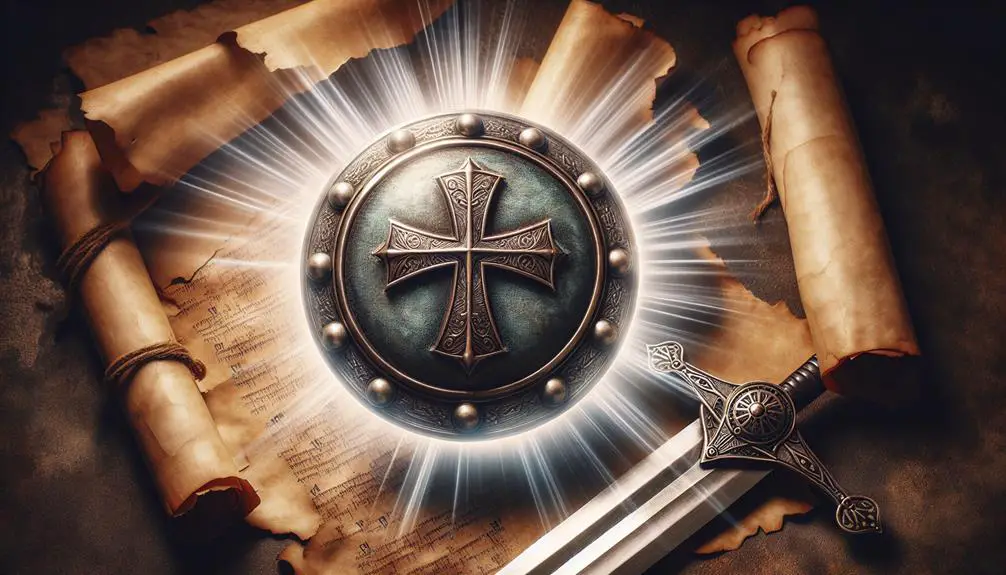
As you explore the concept of armor in spiritual warfare, it's crucial to understand its symbolism and the indispensable role of faith.
The biblical depiction of armor isn't merely about physical protection but signifies spiritual strength and resilience.
The intertwining of these elements highlights the complexity of spiritual battles and the necessity of being equipped with faith.
Symbolism of Armor
The symbolism of armor in spiritual warfare represents the Christian's defense against the forces of evil, embodying faith, righteousness, and divine protection. This imagery draws heavily upon knighthood and medieval warfare, emphasizing the importance of being spiritually equipped. Defensive strategies against spiritual adversaries are underscored through this metaphor.
To further understand, consider:
- Knighthood Imagery: Reflects the Christian as a warrior equipped by God.
- Defensive Strategies: Emphasizes the proactive stance against sin and temptation.
- Full Armor Concept: Illustrates the comprehensive nature of spiritual protection.
- Shield and Sword: Symbolize defense (faith) and offense (Word of God), respectively.
This analytical perspective highlights the multifaceted aspects of spiritual armor, focusing on its significance in the Christian faith without delving into faith's role, which is discussed subsequently.
Role of Faith
Building on the imagery of spiritual armor, it's crucial to understand that faith serves as the cornerstone of this divine protection, equipping believers to effectively confront and overcome spiritual adversities. In the context of spiritual warfare, faith isn't merely an abstract concept but a tangible force that activates and sustains the armor of God.
Through faith, individuals tap into a reservoir of divine strength, enabling them to stand firm against the wiles of the adversary. Faith healing and belief systems play pivotal roles in this dynamic, as they shape the spiritual resilience and capacity of believers to wield spiritual weapons with authority and efficacy.
Consequently, faith transcends being a mere shield; it actively fortifies the believer's entire spiritual arsenal, underscoring its indispensability in spiritual combat.
Personal Application Today
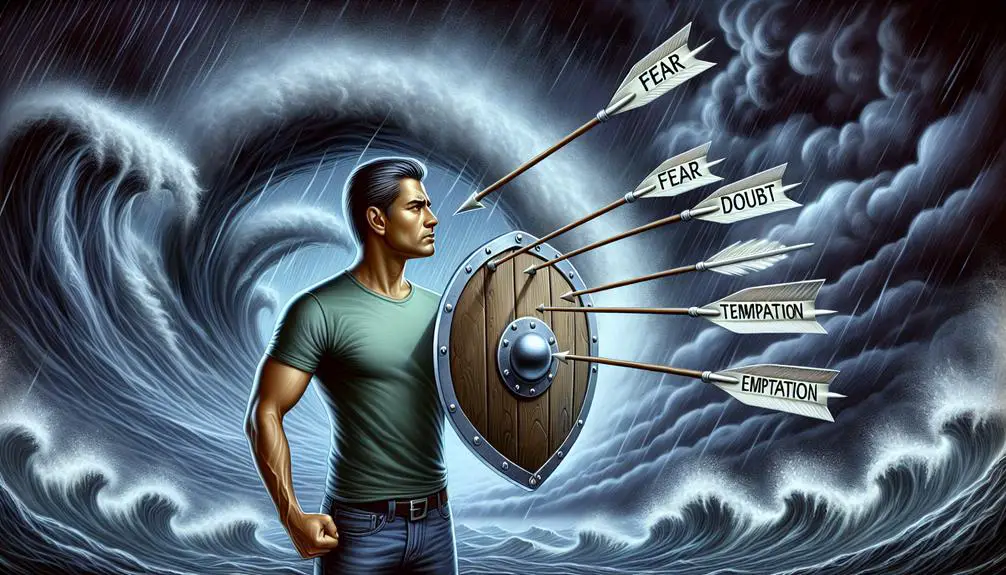
Drawing from ancient texts, you'll find the concept of a buckler, symbolizing protection and divine safeguarding, holds significant relevance in contemporary spiritual practices. Modern interpretations of the buckler extend beyond physical protection, delving into the realm of psychological resilience. This adaptation reflects a deeper understanding of spiritual armor in the face of modern challenges, providing a framework for personal growth and stability.
To integrate the symbolic meaning of a buckler into your daily life, consider the following steps:
- Reflect on Personal Challenges: Identify areas in your life where you feel vulnerable or exposed. Recognize these challenges as opportunities for growth and protection through faith and resilience.
- Cultivate Psychological Resilience: Strengthen your mental and emotional defenses by developing coping strategies that align with your spiritual beliefs. This could involve prayer, meditation, or engaging with a supportive faith community.
- Apply Scriptural Insights: Regularly study scriptures that mention the buckler and other forms of divine protection. Analyze these texts to understand how they can be applied to contemporary issues, fostering a deeper connection with spiritual principles.
- Embrace Divine Safeguarding: Acknowledge the role of divine protection in your life. Trust in the higher power's ability to act as a buckler, shielding you from harm and guiding you through trials with strength and wisdom.
Buckler in Prophecy and Visions

Numerous biblical prophecies and visions incorporate the imagery of a buckler, symbolizing divine protection and intervention in times of spiritual warfare. This use of prophetic imagery and visionary metaphors not only underscores the protective nature of divine power but also serves as a reassurance to the faithful during times of uncertainty and peril.
The metaphor of the buckler, found in various biblical texts, is a powerful component of prophetic language. It isn't merely decorative language; rather, it offers a tangible representation of God's commitment to safeguard His people. This protective imagery aligns with the broader scriptural theme of divine guardianship, where God is often portrayed as a shield or fortress against the forces of evil.
In analyzing these texts, you'll notice that the buckler isn't just a static symbol. It's dynamic, often involved in scenes of divine intervention where God actively shields His people from harm. This active protection highlights the interactive nature of the divine-human relationship, suggesting that God's protection is both a constant and an act of grace in response to faith and prayer.
Furthermore, the inclusion of the buckler in prophetic visions serves a dual purpose. It not only reassures the original audience but also speaks across millennia, offering hope and a sense of divine presence to future generations. This enduring symbol encourages believers to trust in divine protection, even in the face of modern challenges.
Reflecting on the Buckler's Meaning
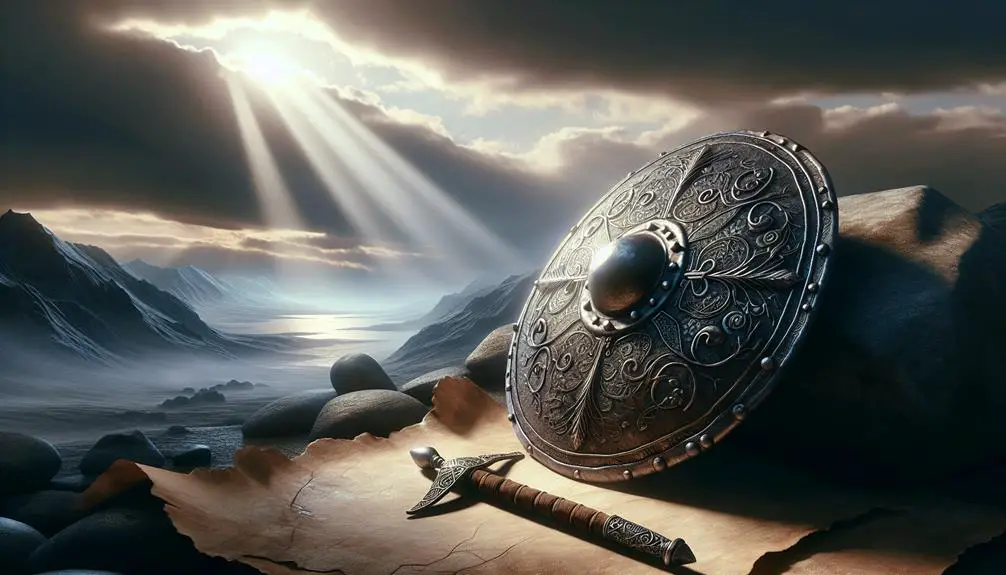
Reflecting on the buckler's meaning within biblical texts reveals its profound role as a symbol of divine protection and assurance. This small shield, while a literal piece of armor, holds much deeper significance when placed within the context of faith and spirituality. Its representation goes beyond mere physical defense to embody the broader concept of safeguarding one's spirit against the trials and tribulations of life. To fully appreciate the buckler's symbolism, it's essential to understand its historical and practical applications, especially in relation to medieval strategies and combat techniques.
- Medieval Strategies: The buckler was pivotal in medieval combat, not just for defense but as an aid in offensive maneuvers. Its use required skill and precision, paralleling the strategic spiritual battles described in the Scriptures.
- Combat Techniques: The versatility of the buckler, capable of deflecting blows and creating openings for counterattacks, mirrors the biblical call to be adaptable and resilient in the face of adversity.
- Symbolic Protection: In biblical terms, the buckler represents God's promise to shield believers from harm. This protection isn't only from physical dangers but also from spiritual and emotional onslaughts.
- Assurance of Safety: The repeated reference to God as a buckler in the Bible emphasizes His unwavering commitment to safeguard His followers. It reassures believers of their safety under divine watch, inspiring confidence amidst life's battles.
Understanding the buckler's dual role in physical combat and spiritual metaphor deepens one's appreciation for its significance in biblical discourse. It serves as a powerful reminder of divine protection and the strength found in faith.
Frequently Asked Questions
How Did the Construction and Design of Bucklers in Biblical Times Differ From Other Forms of Shields Mentioned in the Bible?
In biblical times, bucklers were distinct from other shields due to their construction and design. They were smaller, allowing for more agile combat techniques. Unlike larger shields, bucklers facilitated quick maneuvers.
The materials used also varied, with a focus on lightweight components that didn't compromise protection. This design contrasted with broader shields, which prioritized coverage and were crafted from heavier materials, affecting mobility and the approach to combat situations.
Are There Any Specific Biblical Characters Who Were Noted for Their Use of Bucklers, Outside of Their General Mention in Warfare Contexts?
Interestingly, while discussing shield symbolism, you'll find that specific characters noted for their buckler use are rare. This absence isn't a gap in history but a reflection on character defense.
In an analytical lens, it's clear that biblical narratives often generalize buckler use in warfare, rather than attributing them to individual heroes. This choice subtly emphasizes collective faith and protection over individual prowess, aligning with broader theological themes.
In Modern Archaeological Findings, Have There Been Any Discoveries of Bucklers or Similar Defensive Items That Can Be Directly Linked to the Descriptions Found in the Bible?
In modern archaeological discoveries, you'll find that items resembling bucklers have been unearthed. These findings often reflect the shield materials and combat strategies described in ancient texts.
However, directly linking them to Biblical accounts poses a challenge due to the broad and generic descriptions of military gear in the scriptures.
Your understanding deepens when analyzing these artifacts within the wider historical context of warfare and defense mechanisms of the time.
How Do Various Translations of the Bible Differ in Their Interpretation and Use of the Term "Buckler"?
Imagine you're exploring ancient texts, each with its unique language and cultural context. When it comes to translation differences and interpretation variations of the term 'buckler', you'd find that these nuances significantly impact understanding.
Some translations may depict it as a small shield, offering personal defense, while others could interpret it more metaphorically, as a symbol of protection. These discrepancies highlight the rich complexity and depth of historical texts, demanding careful analysis to grasp their true essence.
Can the Concept of the Buckler Be Found in Other Ancient Religious Texts Outside of the Bible, and if So, How Is It Represented or Understood Differently?
Yes, the concept of the buckler appears in other ancient religious texts beyond the Bible, often imbued with mythological symbolism and cultural significance.
You'll find it represented as a powerful protective symbol, sometimes linked to gods or heroes.
Its understanding varies, reflecting the values and beliefs of each culture.
For instance, in some myths, it's a divine gift, enhancing its bearer's strength or invulnerability, showcasing its deep-rooted role across various civilizations.
Conclusion
In analyzing the buckler's significance within the biblical text, it's noteworthy that this form of shield is mentioned over 30 times, underscoring its importance as a symbol of divine protection and spiritual warfare.
This prevalence highlights how ancient societies valued the buckler not just as physical armor but as a metaphor for God's safeguarding presence.
Reflecting on its usage encourages a contemporary application of seeking divine protection and strength in life's battles, emphasizing the timeless relevance of biblical metaphors in guiding personal faith journeys.

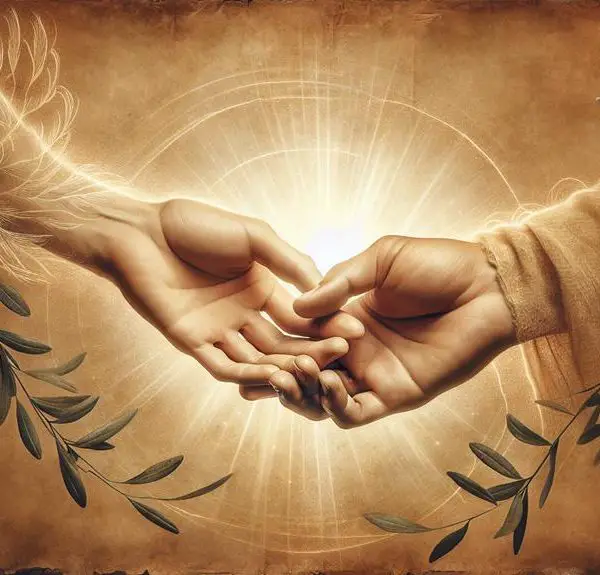
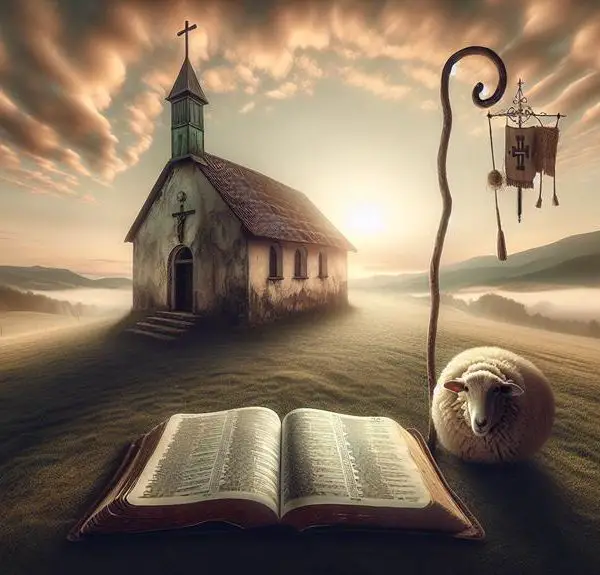
Sign up